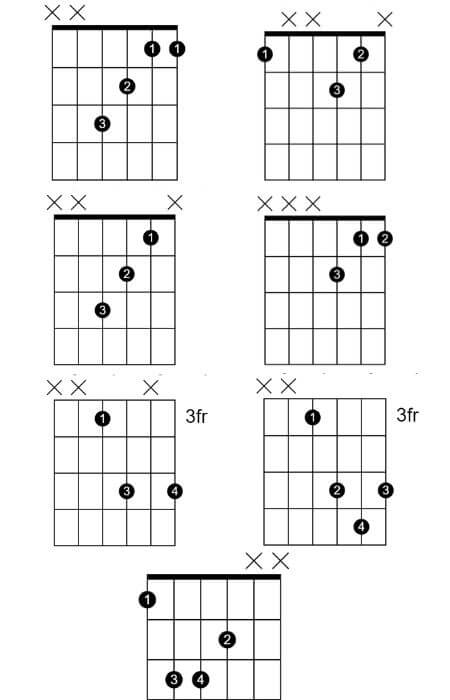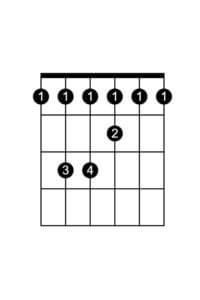7 Easy Ways to Play the F Chord on Guitar
The F chord is a notorious one for guitarists. For many players, it’s a roadblock that seems impossible to get around. Why does the F chord, which usually has guitarists barring the entire first fret, have to come up so often in songs? Why should the F chord be so much harder to play than A, C, D, E, or G?
The answer is, it shouldn’t be! In this post, you’re going to learn 7 easy ways to play the F chord on guitar. For the convenience of anyone using this post as a quick reference, I’ll list all 7 of the F chord shapes below:

Should You Barre F Major?
In my opinion, the F chord doesn’t need to be as challenging as it’s often made out to be. Like most chords on the guitar, the F chord can be played in a variety of ways. These different ways to play F major are other voicings of the same chord.
Many guitarists believe that they should only play the F major voicing below:

While there’s nothing wrong with this version of the F chord, there’s also no reason to use it exclusively. Barre chords take some time to master, and barring the first fret is harder than barring almost any other fret. Why should beginners force themselves to learn this shape? The truth is, they shouldn’t.
Players who are still learning barre chords should definitely practice the F chord shape above and work up to it eventually, but in the meantime, they should be willing to fret easier versions of the F chord without skipping a beat.
I mean, we’re accustomed to playing a four-string D chord, so why can’t we accept a four-string F chord? In my view, barring the entire first fret to play F is totally unproductive for developing players.
At best, the F barre chord makes a lot of players avoid songs with F. At worst, the F barre chord could cause some guitarists to quit playing, thinking they’ll never master the shape.
What Makes a Chord?
A chord can be defined as a harmonic group of two or more notes that are heard as if sounding simultaneously. Technically, when guitarists strum a chord, they’re playing a multiple notes in rapid succession. A quick strum, however, can create the illusion of simultaneity.
The most common type of chord you’ll encounter is called a triad, which consists of three notes: a root note, a note one third above that, and a final note one third above the second (and one fifth above the root). Each chord is ultimately derived from the underlying scale of the same name.
An F major scale (from which we create an F major chord or F chord) consists of F, G, A, B flat, C, D, and E. “F” is the first degree of the scale, so it forms the root note of the chord. “A” is the third degree, while “C” is the fifth degree. You can think of F, A, and C as the ingredients you need to create an F chord.
Given that the guitar fretboard has F, A, and C in many places, there are a bunch of ways to fret these three notes together. That means we don’t need to barre the entire first fret every time an F chord comes up in a song!
Easier Chord Shapes Aren't Cheating!
Some guitarists believe that by fretting an easier version of F, they’re somehow “cheating.” They have a feeling that the F chord needs to be more difficult than, say, the C or D chord.
Well, I’m here to reassure you that you’re not cheating at all. In my view, you’re only doing yourself a favor by learning multiple ways to play the F chord. Just because F is laid out a bit awkwardly on the guitar doesn’t mean we need to always play the hardest shape available.
So do yourself a favor and fret an easier F. You’ll learn barre chords in time, trust me. (And if you are currently struggling with barre chords, you’ll get a lot of help from this post).
How to Learn New Chords
Since this post is all about sharing new chord shapes with you, I thought I might give you some advice on practicing chords in general.
I struggled to learn chords and learn to change chords for a long time. Eventually, I discovered a few secrets that have helped me learn chords faster and enjoy the learning process. (For a full post on how to improve your chord changes, click here).
I have three pieces of advice, and I’ll briefly explain each one afterward:
Slow playing is the foundation of guitar progress. If you don’t play slowly at least some of the time, you’re probably not improving a whole lot. When you’re forming new chords and switching between them, you should be doing so very slowly.
How slow is slow? A good way to judge this is to pay attention to your state of mind. If you’re feeling rushed, stressed, unhappy, disappointed, etc., then you’re probably going too fast.
Slow playing (think of playing in slow motion) should feel relaxed, peaceful, and accurate. You should feel in control, and you shouldn’t be making many mistakes. Once you build a foundation through slow playing, speeding up will come easily.
Isolating your fretting hand will also do wonders for you. It allows your brain to focus all its energy on shaping each chord, rather than splitting its resources between two hands.
You should be willing to spend a 5-15 minutes fretting chord shapes without playing them, plus practicing certain changes. I consider this crucial to left-hand fluency.
3) Learn to love each chord shape
Finally, you should try to love each chord shape. Any negative attitude you hold about any aspect of guitar playing needs to go.
I’ve found that the more I appreciate the feel, look, and sound of a chord, the better. This is a kind of mental practice, and you can definitely work on it away from the guitar.
Conclusion
Hopefully by now you believe that the F chord doesn’t have to be as hard as people make it. Learning an easier shape for now won’t set you back in the long run. Work on those barre chords a little bit every day, and you’ll be playing the six-string version of F in no time at all.
Are there any other F shapes that you like to use? Be sure to let me know in the comments!
Looking to upgrade your gear or browse some awesome guitar learning materials? Check out my recommendations page to see all my favorite stuff.
Want to streamline your fingerstyle guitar progress? I just released my new ebook, Fingerstyle Fitness, which presents 10 easy exercises to quickly develop your fingerstyle chops. Grab it today!